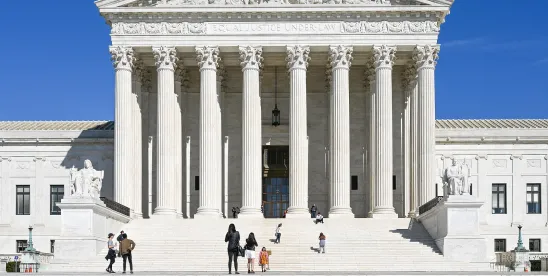An employee challenging a job transfer under Title VII of the Civil Rights Act must show the transfer brought about some harm with respect to an identifiable term or condition of employment, but that harm need not be significant, the U.S. Supreme Court held in Muldrow v. City of St. Louis, Mo., No. 22-193 (Apr. 17, 2024).
While the case was about transfers, it will have broad applicability in discrimination cases. The opinion, written for the Court by Justice Elena Kagan, resolves a circuit split over whether an employee challenging a job transfer under Title VII must meet a heightened threshold of harm. Previously, some circuit courts of appeals, including the First, Second, Fourth, Seventh, Eighth, Tenth, Eleventh, and D.C. Circuits, required Title VII plaintiffs to show “serious,” “significant,” or “material” harm related to terms, conditions, or privileges of employment to bring a claim. In those circuits, employment actions such as transfers without an associated decrease in pay or responsibilities would not meet the higher standard. Although the Court eliminated a heightened threshold for harm under Title VII, it left open the question of what showing of harm would be sufficient for Title VII purposes.
The Case
Petitioner Jatonya Muldrow of the St. Louis Police Department argued that her eight-month transfer out of the Department’s Intelligence Division constituted sex discrimination within the meaning of Title VII, even though she had not suffered any economic damages as a result of the transfer. The federal district court dismissed Muldrow’s discrimination claim, finding she had failed to establish proof of “significant” harm resulting from the transfer. The U.S. Court of Appeals for the Eighth Circuit affirmed the decision.
Supreme Court Opinion
The Supreme Court rejected this approach, as well as any heightened standards of harm that lower courts had required for bringing a Title VII claim. In so holding, the Court applied a textual analysis of Title VII.
The Court observed the statutory language of Title VII prohibits “discriminat[ing] against” an individual “with respect to” the “terms [or] conditions” of employment because of a protected characteristic. This language, the Court reasoned, required the petitioner to establish some disadvantageous change to an identifiable term or condition of employment as the term “discriminate” has been found to mean “differences in treatment that injure employees.” However, the Court held, the language of Title VII does not require that a Title VII plaintiff establish the change was “significant,” “serious,” “substantial,” or any other heightened burden. Rather, the term “discriminate against” in Title VII means to “treat worse.” To require more from a Title VII plaintiff, the Court reasoned, was to demand something other than what the plain language of Title VII required.
The Court rejected the City’s argument that eliminating a threshold showing of significant or material injury requirement to bring a cognizable claim under Title VII would lead to a flood of “insubstantial lawsuits.” The Court concluded that a plaintiff would still have to overcome several hurdles to establish a Title VII claim. This would include establishing an injury that impacted a term or condition of employment and that the injury occurred because of the plaintiff’s protected characteristic.
In reversing the courts below, the Court remanded the case to the lower courts to determine whether Muldrow had a meritorious Title VII claim related to her transfer. The Court noted that if the allegations raised regarding the negative effects the job transfer had on Muldrow were proven, they would be sufficient to establish she was “worse off several times over.” Muldrow alleged the transfer moved her from a plainclothes job in a prestigious, specialized division with substantial responsibility over priority investigations and frequent opportunity to work with police commanders to a uniformed position supervising one district’s patrol officers primarily performing administrative work. The Court said, “All we require is that [the lower courts] use the proper Title VII standard, and not demand that Muldrow demonstrate her transfer caused ‘significant’ harm.”
Concurring Opinions
The Court also directly addressed a criticism of its decision raised by Justice Clarence Thomas in his concurring opinion. Justice Thomas challenged the notion that the lower courts had imposed a heightened burden by requiring a Title VII plaintiff to establish a “substantial disadvantage” or that lower courts would have to change their treatment of Title VII claims going forward. The Court emphasized that its decision was eliminating any legal standard used by Courts that required a Title VII plaintiff to establish a “‘significant,’ ‘material,’ or ‘serious’ injury” and lowering the bar plaintiffs must meet. Consequently, the Court stated it anticipates that Title VII cases will have different results under this new standard.
Justices Samuel Alito and Brett Kavanaugh also wrote concurring opinions. In his concurrence, Justice Alito explicitly described the majority opinion as “unhelpful,” stating, “… after briefing and argument, th[e Court’s] guidance is as follows: Title VII plaintiffs must show that the event they challenge constituted a ‘harm’ or ‘injury,’ but that the event need not be ‘significant’ or ‘substantial.’ I have no idea what this means, and I can just imagine how this guidance will be greeted by lower court judges.” Justice Alito concluded the courts “would continue to do what they had been doing before.”
Justice Kavanaugh articulated a position he took in Ortiz-Diaz v. United States HUD, 867 F.3d 70 (2016), when he sat on the D.C. Circuit. He opined that there need not be a showing of any harm, a discriminatory action alone is all that the statute requires. Therefore, if the City of St. Louis effectuated a discriminatory transfer, then it violated Title VII.
From Justice Kavanaugh’s perspective, the “some harm” requirement does not appear in Title VII, as the discrimination itself is the harm experienced by the plaintiff. For Justice Kavanaugh, the appropriate inquiry is whether the challenged employment action changed the “compensation, terms, conditions, or privileges of employment[,]” something that was clearly met by a transfer on the basis of a protected characteristic.
Implications
Although the Court’s opinion dismissed the “floodgate” argument, it is hard to imagine that this ruling will not increase the number of Title VII claims brought over a myriad of workplace conditions that, prior to Muldrow, would have been considered too trivial to ground a Title VII claim. Whether described as “substantial harm,” “some harm,” or “de minimis harm,” courts have consistently held that Title VII is not intended to reach every employment action a person may find disagreeable.
Of particular importance is the applicability of this opinion to employers’ diversity, equity, and inclusion (DEI) programs. While Justices Thomas and Barrett asked questions during oral argument about the potential impact of the Court’s decision on these programs, the decision itself is silent on the matter. Nonetheless, DEI-challengers bringing Title VII claims must meet their burden of proving their case, which still includes a requirement of showing some harm. In his concurrence, Justice Alito differentiated between harms with “some degree of significance or substantiality” from mere “unwanted experiences” such as a supermarket running out of a favorite brand of peanut butter or encountering more red lights than usual during a commute. Courts will undoubtedly have to consider whether a plaintiff who objects to various DEI programs has experienced the requisite degree of harm to bring a Title VII claim.








 />i
/>i
